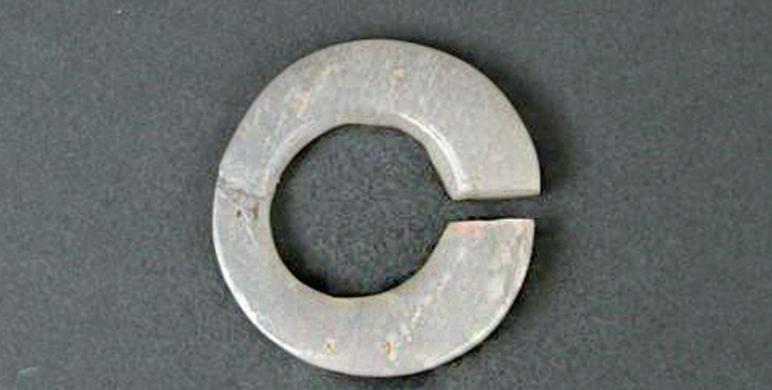Jade Ring: A symbol of islander exchange and maritime connection
Updated:2025-05-19 | Lin Kongbo, Stephanie
Jade Ring
Name: Jade Ring
Excavation Site: Keqiutou site, Pingtan
Function: Ancient jade ornament
Era: Neolithic Period
Age: Approximately 6,500–5,500 years
Archaeological Findings:
The Keqiutou site discovered its only jade ring and serves as evidence of exchange between islanders and mainlanders. It is 4.3 cm in outer diameter, 2.2 cm in inner diameter, and 0.4 to 0.7 cm thick. With a smooth, greenish-white surface, its unique ring shape was used as an ornament, similar to modern-day earrings.
Since jade is not naturally found in Pingtan, it is believed that the jade was acquired through trade—a practice common in the Neolithic period.
Research shows that jade rings were quite common in prehistoric cultures. During the Neolithic Age, the core area of jade ring usage gradually spread from the Yangtze River region both southward and northward. This expansion was likely the result of joint influences from both the middle and lower reaches of the Yangtze River.
A jade ring is an ancient jade ornament, characterized by its ring shape with a gap. The outer contour of the ring was traditionally called the "meat" (肉), which corresponds to the outer diameter, determining the overall size of the object. For ring-shaped jade rings, there are two types: perfectly round and non-circular, so the outer diameter and height may not always be equal. The inner hole of the ring was traditionally called the "hao" (好), representing the inner diameter, which ultimately determines whether the jade ring was worn as an earring or served as another type of decoration.Jade rings could be directly worn on the ear, but the gap of the ring had to be cut to an appropriate size; if the gap was too large or too small, the ring could not be worn directly.
In the Neolithic Age, jade rings were always luxury ornaments enjoyed by only a few people. Although there were differences among various regions and settlements, these ornaments reflected social status and aesthetic preferences, showing a gradual deepening of appreciation for jade.
According to Hou Ronggui, deputy director of the Pingtan International Austronesian Research Institute, a jade ring found at the Keqiutou site on Haitan Island indicates that 6,500 to 5,500 years ago, Austronesian ancestors had already mastered relatively advanced seafaring skills, enabling them to travel freely between islands.
Additional context:
Jade is deeply ingrained in Chinese cultural heritage. China is the earliest and longest user of jade in the world and is known as the "Country of Jade." In the early Neolithic period, jade rings were mostly excavated in the northeast region. By the middle Neolithic period, jade rings had spread southward and became prevalent in both the northeast and the middle and lower Yangtze River regions. However, by the late Neolithic period, jade rings, once widespread in northeast and Yangtze regions, were rarely found there, but the use of jade rings continued to spread southward, forming a key development area centered in the Fujian-Taiwan region and radiating to Guangxi, Guangdong, and Hainan.

